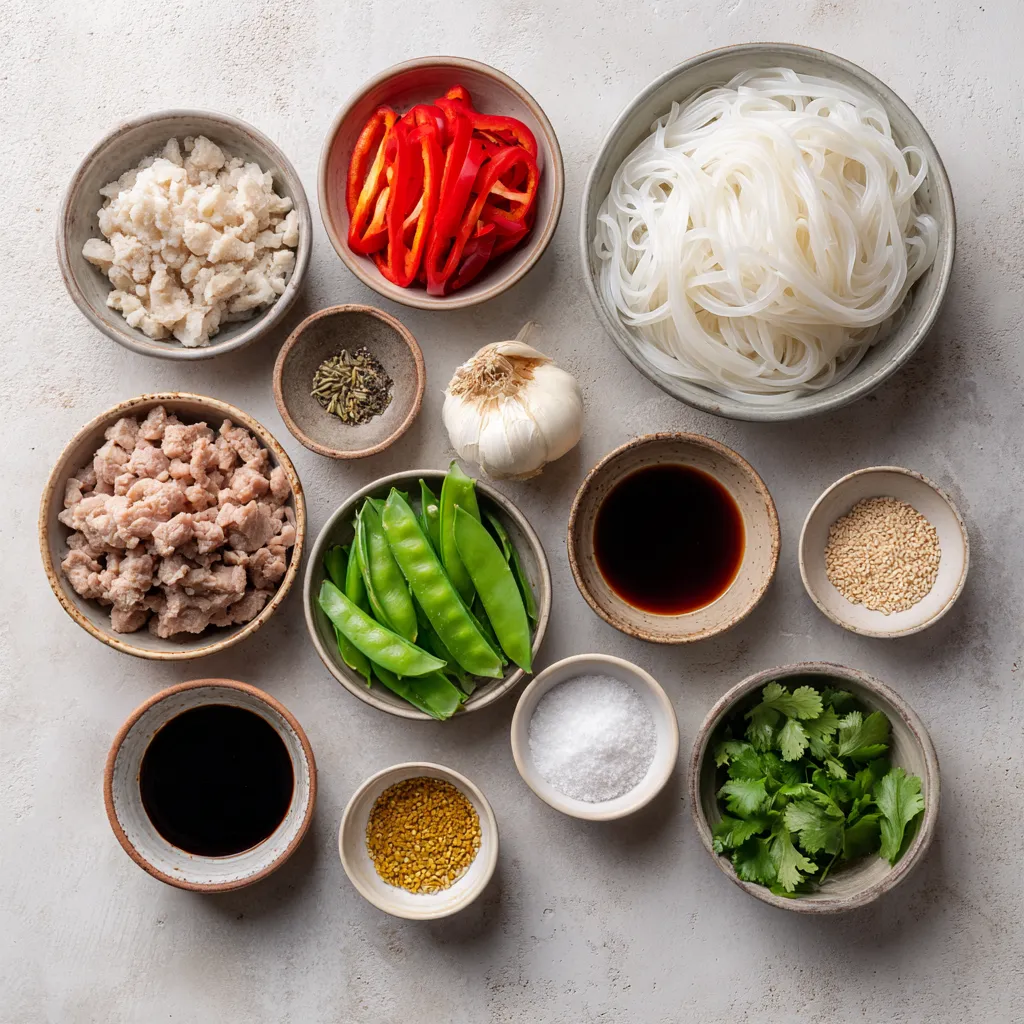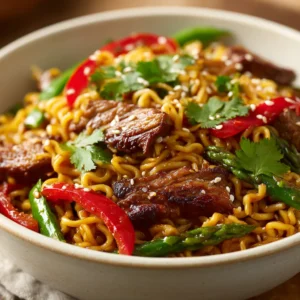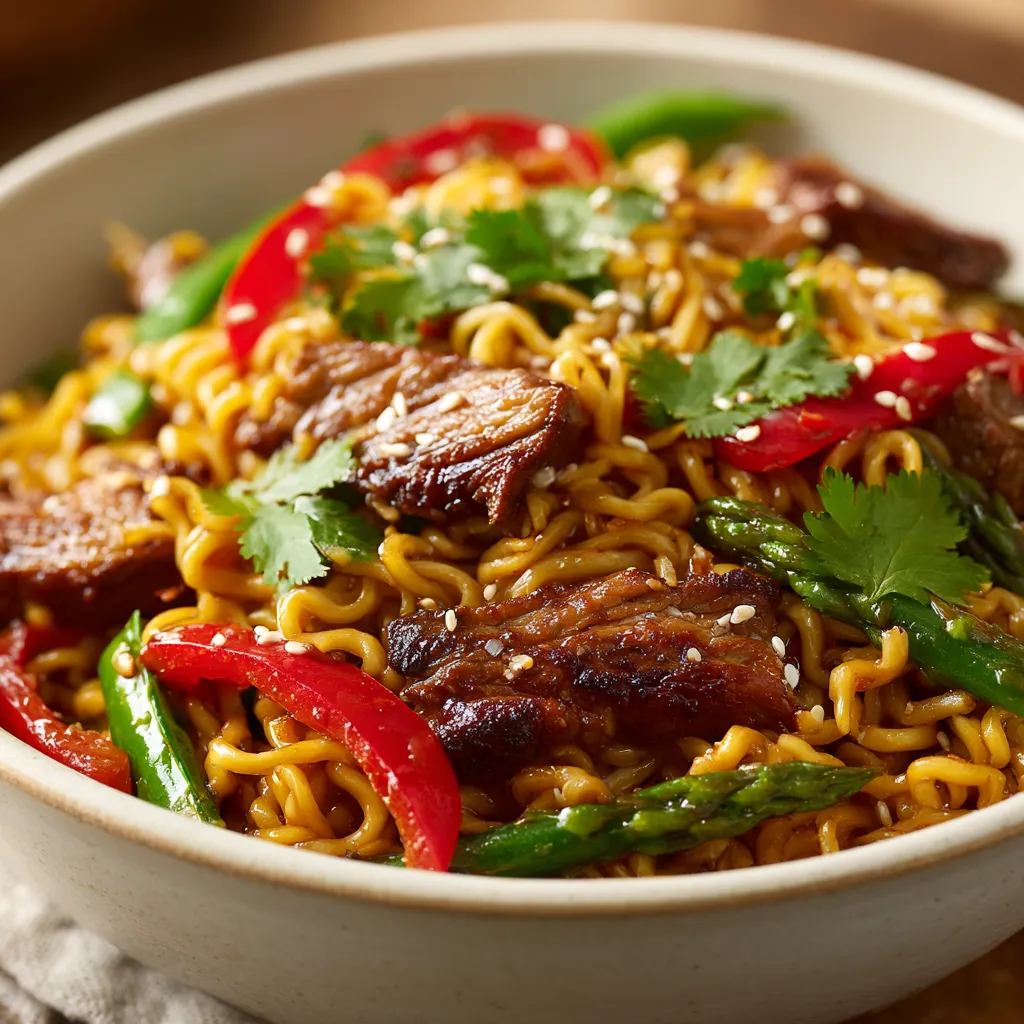Introduction
An exploration of the savory flavors of Teriyaki Pork Noodles is an adventure into the world of delicious Asian cuisine. This dish combines tender pork loin, fresh vegetables, and delicate rice noodles in a sweet and savory teriyaki sauce. The allure of Teriyaki Pork Noodles lies not only in its flavorful profile but also in the visual appeal created by the colorful vegetables and the glossy sauce. Whether you’re looking for a quick weeknight meal or seeking to impress your guests during a dinner party, this recipe promises to delight your taste buds and satisfy your cravings.
The balance of protein from the pork, crunch from the vegetables, and the umami-rich teriyaki sauce comes together to create a wholesome, comforting meal. The sweet hint from the mirin and brown sugar complements the savory soy sauce, making each bite a perfect harmony of flavors. These noodles are not just delicious but also present an easy cooking experience, making it accessible for cook enthusiasts of all levels.
Recipe Overview
– Total Time: 30 minutes
– Yield/Servings: 4 servings
– Difficulty: Not specified in the recipe.
Ingredients
– 300g pork loin, thinly sliced
– 200g rice noodles
– 2 tablespoons vegetable oil
– 3 cloves garlic, minced
– 1 inch piece of ginger, grated
– 1 red bell pepper, cut into thin strips (julienned)
– 1 cup snap peas, trimmed
– 4 green onions, sliced
– ¼ cup soy sauce
– ¼ cup mirin (a sweet rice wine)
– 2 tablespoons brown sugar
– 1 tablespoon sesame oil
– 1 teaspoon cornstarch mixed with 1 tablespoon water
– Sesame seeds for garnish
– Fresh cilantro for garnish (optional)

Instructions
1. Prepare the Noodles: Begin by cooking the rice noodles according to the instructions on the package. Once cooked, drain and rinse them under cold running water to stop the cooking process. Set the noodles aside for later use.
2. Marinate the Pork: In a mixing bowl, combine the soy sauce, mirin, brown sugar, and sesame oil. Add the thinly sliced pork to the bowl, ensuring each piece is well coated in the marinade. Allow the pork to marinate for at least 15 minutes for optimal flavor absorption.
3. Cook the Pork: Heat 1 tablespoon of vegetable oil in a large skillet or wok over medium-high heat. Once hot, add the marinated pork (making sure to reserve the leftover marinade). Sauté the pork for approximately 5-7 minutes, or until it is browned and fully cooked. Remove the cooked pork from the skillet and set it aside.
4. Stir-fry the Vegetables: In the same skillet, add the remaining tablespoon of vegetable oil along with the minced garlic and grated ginger. Stir-fry these aromatics for about 30 seconds until they become fragrant. Introduce the julienned red bell pepper and snap peas, cooking for 3-4 minutes, until the vegetables are colorful and slightly tender but still crisp.
5. Combine Everything: Return the cooked pork to the skillet with the vegetables. Pour in the reserved marinade and allow the mixture to come to a gentle simmer. Add the cornstarch mixture, stirring constantly until the sauce thickens, which should take about 1-2 minutes.
6. Toss in the Noodles: Add the prepared rice noodles into the skillet with the pork and vegetables. Gently toss everything together, ensuring that the noodles are evenly coated in the rich sauce and warmed through. Incorporate the sliced green onions into the mixture.
7. Serve: Plate the delicious teriyaki pork noodles in individual bowls. For an appealing touch, sprinkle sesame seeds on top and add fresh cilantro if desired. Dive into this delightful meal and savor the flavors!
Cooking Rice Noodles
Cooking rice noodles properly is fundamental to achieving the right texture and making sure they blend seamlessly with the sauce and ingredients. The method of preparation can make all the difference between a dish that feels cohesive and one that falls flat. The first step involves boiling the rice noodles—stick to the package’s instructions for precise cooking times, as different brands may vary.
Selecting the Right Rice Noodles
There are various types of rice noodles available, including flat and round varieties. Flat rice noodles, often used for dishes like Pad Thai, work well in this recipe as they hold sauce beautifully. Round rice noodles, often found in soups, can also be used but may result in a slightly different texture. Regardless of the type you choose, ensure they are labeled as suitable for stir-frying for optimal flavor and integration into your Teriyaki Pork Noodles.
Cooking Methods
Typically, rice noodles require soaking or boiling, depending on the brand and thickness. Generally, bring water to a boil and add the noodles, cooking for a designated time until they are just tender but still have a bite to them (al dente). After draining, it’s critical to rinse them under cold water immediately. This not only stops the cooking process but also prevents the noodles from becoming gummy, maintaining the desired bite for your final dish.
Rinsing and Draining
Rinsing the noodles is an essential step to keep them from sticking and becoming clumpy as they cool. This simple act of running cold water over the noodles helps separate them, allowing for better incorporation with the other ingredients later on. Well-rinsed noodles can absorb sauces more effectively and will provide a pleasant texture when intertwined with the tender pork and crisp vegetables in the final dish.
Marinating the Pork
Marinating pork for this Teriyaki dish elevates its flavor and enhances its tenderness. The marinade mixture includes soy sauce, mirin, brown sugar, and sesame oil, which collectively create a rich flavor profile.
Creating the Marinade
The marinade’s soy sauce acts as a savory base rich in umami, while mirin adds a gentle sweetness and depth. Brown sugar contributes to caramelization during cooking, enhancing the texture and adding a subtle sweetness that complements the savory notes. The sesame oil adds a nutty fragrance, elevating the overall sensory experience of the dish.
Marinating Process
To maximize flavor absorption, do not rush the marination process. Allowing the pork to marinate for at least 15 minutes, or even longer if time permits, ensures that the flavors penetrate the meat. For those with ample time, consider marinating the pork for up to an hour or more, allowing it to soak in every layer of flavor presented by the marinade ingredients.
Cooking the Pork
Cooking the marinated pork properly is crucial for achieving a tender and juicy bite.
Heating the Skillet
Start by preheating your skillet or wok to medium-high heat for even cooking. This is an essential step, as it allows the pork to sear properly, creating a caramelized crust while locking in moisture.
Sautéing Pork to Perfection
Once the skillet is hot, add the first tablespoon of vegetable oil, followed by the marinated pork. The cooking time should be about 5-7 minutes. Sauté until the pork is golden brown and fully cooked. This visual cue indicates doneness, ensuring that the meat remains juicy yet cooked through. It’s important to keep an eye on the heat; if it’s too high, the pork may brown too quickly on the outside without cooking through, leading to undesirable texture.
Storing Leftover Marinade
Once you have cooked the pork, the leftover marinade can be reused in the dish. However, it’s important for food safety to ensure that it is either boiled to kill any bacteria from the raw meat or not reused at all. The decanted marinade can then be added back to the stir-fried vegetables and pork to create a rich, flavorful sauce that ties together the entire dish.
Stir-frying the Vegetables
Stir-frying is a quick cooking technique that preserves the color, crunch, and nutrients of vegetables. It allows the teriyaki flavors to meld perfectly with each ingredient while creating a vibrant dish.
Selecting Fresh Vegetables
For this recipe, fresh vegetables like red bell pepper and snap peas not only add color but also a crisp texture that balances the tender noodles and pork. Vibrant vegetables will enhance both the nutritional content and visual appeal of your dish. Always look for firm, brightly colored produce with no signs of wilting.
Aromatics – Garlic and Ginger
Garlic and ginger carry essential roles in enhancing the overall flavor of the Teriyaki Pork Noodles. They are typically stir-fried at the beginning to infuse the oil and build a flavor base for the dish. A quick sauté allows their natural oils to release and permeate the dish with warm, spicy notes.
Cooking Vegetables to Ideal Crispness
When stir-frying vegetables, timing is key to retaining their crunch. Start with the aromatics, and after about 30 seconds, immediately add in the bell pepper and snap peas. Cooking them for just 3-4 minutes allows them to become tender yet still maintain a slight crispness, which is essential to creating a lovely contrast in texture against the tender pork and noodles. Overcooking can lead to a loss of vibrancy and nutrition, so it’s crucial to keep them colorful and firm.
Combining Ingredients
Integrating all the components of the Teriyaki Pork Noodles is the final step that binds together the textures and flavors for a complete meal.
Returning Pork to Skillet
Once the vegetables are cooked to perfection, return the sautéed pork back into the skillet. By reintroducing the pork, all its juices blend with the vegetables, enhancing the flavor complexity. Pouring in the reserved marinade allows everything to simmer and meld together as the sauce thickens to coat the ingredients beautifully, making every bite perfectly seasoned and rich.
The Teriyaki Pork Noodles delight brings comfort food to the next level, fusing flavors and textures in a vibrant dish that’s not only delicious but looks appealing when served.
{{image_4}}
Incorporating the Marinade
When reintroducing the cooked pork to the vegetables, it’s crucial to allow for proper layering of flavors. Begin by pouring the reserved marinade over the sautéed vegetables. This method ensures that the flavors from the marinade infuse not only the pork but also the vegetables, creating a cohesive dish. As the mixture simmers gently, it allows the components to meld together, with the heat enhancing the sweetness of the brown sugar and the umami taste of the soy sauce. Simmering is key here; it heightens the overall flavor and ensures that no ingredient is far removed from the vibrant taste that defines teriyaki.
Thickening the Sauce
To achieve the desired sauce consistency, introduce the cornstarch mixture to the skillet after the marinade has simmered with the pork and vegetables. It’s essential to stir constantly during this process to avoid clumping and ensure even thickening. As the cornstarch activates upon contact with heat, you will notice the sauce transforming into a perfect glossy finish that clings nicely to the noodles and meat without being overly runny. Maintain a delicate simmer to promote a uniform integration of the sauce with the other ingredients.
Tossing in the Noodles
Gently folding in the rice noodles is the next step to create a harmonious dish.
Timing for Noodle Addition
Add the noodles to the skillet only when the sauce has thickened and the pork and vegetables are hot and well combined. This timing is essential; introducing them too early can lead to overcooked noodles that lose their texture and integrity. For the best results, the noodles should be first heated through, ensuring that they absorb the flavors of the teriyaki sauce as they mingle with the other components.
Mixing Techniques
When incorporating the rice noodles, use a gentle tossing motion with tongs or a large spatula to avoid breaking them. Carefully lift the noodles from the bottom, rotating them into the mix to ensure they are evenly coated. Take your time to achieve that delicious integration without the risk of mushiness.
Final Flavor Adjustments
As you toss everything together, keep an eye on flavor balance. Taste for seasoning; if it seems a bit shy, additional soy sauce or a dash of salt can elevate the dish. Finally, stir in the sliced green onions at the end to retain their crunch and vibrant color, giving an extra depth of flavor and visual appeal.
Plating and Presentation
Thoughtful presentation elevates the Teriyaki Pork Noodles from tasty to impressive.
Plating Techniques
When plating, use a deep bowl to contain the noodles and prevent spills. Place a generous helping of the noodle mixture in the center of the bowl, allowing some to cascade naturally along the sides for an appealing, informal look. The stacking method not only provides height but also makes the dish visually stunning.
Garnishing Ideas
For garnishing, sprinkle toasted sesame seeds over the top for a nutty crunch and a touch of sophistication. Adding fresh cilantro can also brighten the dish and introduce a lovely aroma. Consider arranging a few snap peas and elegantly sliced red bell peppers atop the noodles for contrast and a hint of freshness. Accentuate with a lime wedge on the side for a zesty, colorful pop that enhances both presentation and flavor.
Serving Suggestions
To enjoy the teriyaki experience to its fullest, consider serving the noodles with light accompaniments. A side salad made with cucumbers and rice vinegar provides a crisp and refreshing counterbalance to the richness of the dish. Alternatively, crispy spring rolls serve as a complementary starter.
Flavor Profile Description
The Teriyaki Pork Noodles are rich in diverse flavors, each playing a significant role in the overall harmony of the dish.
Sweetness from Brown Sugar and Mirin
The sweetness derived from both the brown sugar and mirin provides a delightful counterpoint to the salty depth of the soy sauce. This simple interplay between sweetness and umami creates a balanced taste that elevates the dish.
Umami Depth from Soy Sauce
Soy sauce is instrumental in enhancing the overall flavor profile of the teriyaki sauce. Its salty nature combines well with other elements such as the marinade, elevating the dish’s overall satisfaction by providing depth that lingers on the palate.
Freshness from Vegetables and Garnishes
The addition of colorful vegetables contributes not just to the visual appeal but also introduces layers of freshness and texture. Crunchy snap peas and crisp bell peppers complement the soft noodles and succulent pork, ensuring that each bite is balanced. The garnishes of sesame seeds and herbs enhance this freshness, working together to offer a rounded and fulfilling dish.
Variations and Adaptations
To cater to a variety of palates and dietary needs, consider some simple adaptations.
Using Alternative Proteins
If you prefer a different protein, swap the pork loin for chicken, beef, or tofu, which can provide a unique texture and flavor. Adjust cooking times accordingly; for instance, chicken may require slightly longer cooking to ensure it is fully cooked and tender.
Gluten-Free Options
For those with gluten sensitivities, choose a gluten-free soy sauce or tamari in place of regular soy sauce. Additionally, ensure that the rice noodles selected are gluten-free, opening the dish to broader dietary inclusion.
Vegetable Variations
Feel free to add seasonal vegetables to enhance the dish’s appeal. Carrots, broccoli, or bok choy can all work beautifully as substitutes or additions, boosting both nutrition and flavor diversity.
Storage and Reheating Tips
To keep leftover Teriyaki Pork Noodles fresh, proper storage is key.
Refrigeration Guidelines
Store the leftovers in an airtight container, ensuring that the noodles and other ingredients are entirely cooled before sealing. Proper storage will help maintain freshness, and the dish will generally be good for 2-3 days in the refrigerator.
Reheat Techniques
To reheat, place the noodles in a stovetop skillet over medium heat with a splash of water or oil to prevent sticking. Stir frequently until warmed through. Alternatively, microwave in short bursts, stirring between intervals to ensure even heating without drying out the noodles or pork.
Conclusion
Teriyaki Pork Noodles present a delightful blend of sweet, salty, and fresh flavors, balanced perfectly for a satisfying meal. With a total cook time of about 30 minutes, this dish combines ease and elegance, making it a favorable choice for quick weeknight dinners or gatherings. Each bite delivers a comforting experience, enhanced by the varied textures of the ingredients.


